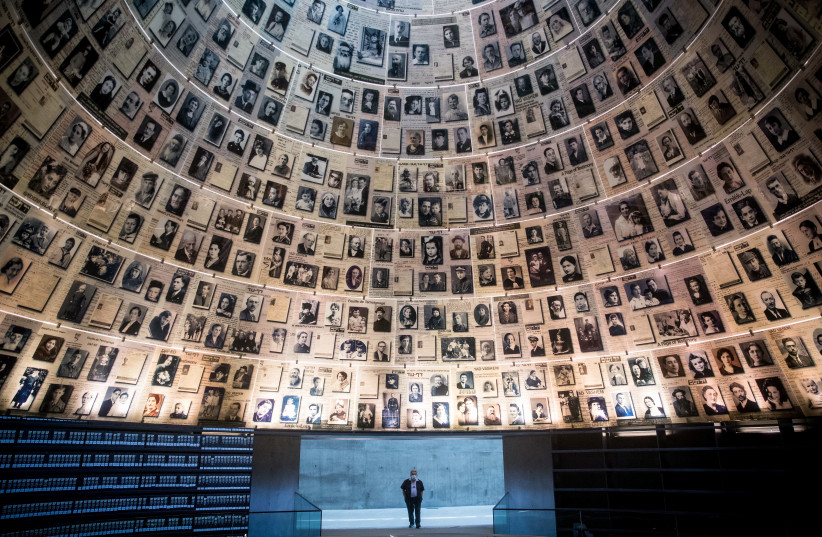In 1921, when he was just six months old, my father was smuggled in a potato sack across international borders. Desperately fleeing antisemitic pogroms in the Ukraine, my grandparents set out on a perilous journey to reach relative safety in Poland. They placed their infant son into the sack and, knowing his cries risked immediate death for them all, muffled his tiny mouth with a cloth, praying they would survive the journey. Upon arrival in Poland, they were relieved to find their precious son alive. Because of their strength of spirit, I am here to tell their story – a unique narrative, but representative of the tale of much of European Jewry.
Exactly 100 years later, I have taken on a new role as chairman of Yad Vashem.
I was tasked with the privilege and tremendous responsibility representing the State of Israel for four years as consul general in New York. In that role, I, too, crossed many international borders, but this time under diplomatic protection with a wave of my Israeli passport. Furthermore, unlike many Jews from across Europe who for generations felt forced to hide their Jewish roots, I was empowered by the words “State of Israel” in English and Hebrew, together with the menorah, a distinct Jewish symbol, emblazoned both on my diplomatic passport and on my heart.
These two border-crossing stories, astonishing in their differences, are just one illustration of the transformative experiences undergone by the Jewish people in our time. Barely two decades after my grandparents’ and father’s miraculous escape from murderous antisemites, the world witnessed humanity sink to its lowest depths during the Shoah – the systematic murder of two thirds of European Jewry.
I consider myself among the fortunate, cushioned by safety as my immediate ancestors narrowly escaped the Holocaust. I was born and raised in Buenos Aires, Argentina, and moved to Israel at the age of 15. Yet, wherever I have lived, the legacy of the Shoah was never far from my mind. It was instilled in my memory as I grew up as part of a Jewish minority in Latin America, and later as I became an adult in our Jewish homeland in Israel. The Holocaust is part of the collective Jewish experience, and while Yad Vashem will forever belong to the Jewish people, it also serves as a beacon to the entire world.
As I commence my new position as chairman, I strive to meet this enormous responsibility. During a recent walkabout on Yad Vashem’s campus on Jerusalem’s Mount of Remembrance, I was compellingly struck by the final words of Gela Seksztajn, a brilliant Jewish artist from Warsaw who was murdered in Treblinka, at the entrance to the Museum of Holocaust Art:
“As I stand on the border between life and death, certain that I will not remain alive, I wish to take leave from my friends and my works…. My works I bequeath to the Jewish museum to be built after the war. Farewell, my friends. Farewell, the Jewish people. Never again allow such a catastrophe.”
Unfortunately, the mission bequeathed to us by Gela and the other six million Jewish men, women and children murdered by the Nazis and their collaborators is today threatened by the willful manipulation of history and memory, a dangerous phenomenon of late. We must remain wary of those who seek to exploit the events of the Holocaust or rewrite their role in history when they deem it politically expedient to do so. Holocaust distortion and appropriation can take on many forms. In some cases, politicians exaggerate their own nations’ recalled altruism and wartime moral compass. In international discourse, competing narratives of victimhood are thrust upon one another; in other cases, victims, bystanders, collaborators and perpetrators alike are simplistically painted with the same brush. Such cynical manipulations threaten our quest for a more just world.
I just returned from Kyiv, where I opened an academic conference about the phenomenon of mass shootings during the Holocaust and participated along with the presidents of Israel, Ukraine, Germany and Albania in memorial events organized by the government of Ukraine, in conjunction with the Babyn Yar Holocaust Memorial Center, currently in development.
Now, 80 years later, I have the vital task of representing the memory of the victims of Babi Yar, as well as all of six million Holocaust victims. It is our Jewish, human and moral duty to remember the men, women and children murdered in the valley of death, and never to let their faces fade away.
It is imperative that wherever the Holocaust is commemorated, especially in places where various forces have sought over the years to erase our memory of the victims, historical truth must be protected forever. Yad Vashem will not allow the memory of the Holocaust to wane; and I hereby redouble our commitment to protect and disseminate the legacy of the Holocaust and its victims for the sake of future generations of the Jewish people, and humanity as a whole.
The writer is chairman of Yad Vashem, the World Holocaust Remembrance Center.

